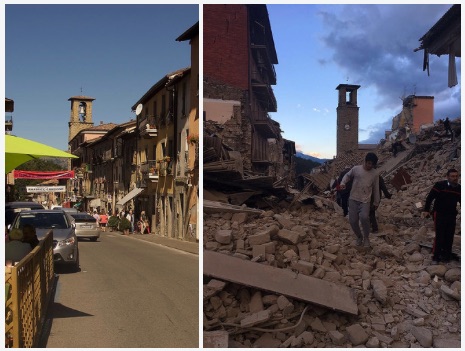 Many are aware that dinosaurs disappeared nearly 66 million years ago, after a major climate change that made their environments inhospitable. Most people know about the dinosaurs disappearance, but few know that what happened at the end of the Mesozoic era was actually a mass extinction. Well, maybe even fewer people know that some clues of what happened in that period have been first found in central Italy, close to Saint Francis’ hometown, near a small city in the Apennines called Gubbio. The story is about father and son, Louis Alvarez, a Nobel prize physicist, and Walter Alvarez, a renown American geologist at Berkeley with a love for Italy.
Many are aware that dinosaurs disappeared nearly 66 million years ago, after a major climate change that made their environments inhospitable. Most people know about the dinosaurs disappearance, but few know that what happened at the end of the Mesozoic era was actually a mass extinction. Well, maybe even fewer people know that some clues of what happened in that period have been first found in central Italy, close to Saint Francis’ hometown, near a small city in the Apennines called Gubbio. The story is about father and son, Louis Alvarez, a Nobel prize physicist, and Walter Alvarez, a renown American geologist at Berkeley with a love for Italy.
Geology
The geology of Rome’s sampietrini
 What’s so special about the “sampietrini”, those little square bricks typical of Rome’s old roads? The sampietrini have been used since the times of pope Sixtus V in the late 1500s but the name was invented later in 1725 after the new paving project of St. Peter’s square. “Hard as a sampietrino” is a common expression in Rome. Sampietrini are made of a hard and heavy volcanic rock. It is very interesting to a geologist: at first sight, you might confuse it with basalt; well, maybe a special kind of basalt. Actually, it is not correct to call it basalt. It is a rather rare rock around the world, although not in the Mediterranean area. But everything would be clearer if we knew more about the basalts themselves…
What’s so special about the “sampietrini”, those little square bricks typical of Rome’s old roads? The sampietrini have been used since the times of pope Sixtus V in the late 1500s but the name was invented later in 1725 after the new paving project of St. Peter’s square. “Hard as a sampietrino” is a common expression in Rome. Sampietrini are made of a hard and heavy volcanic rock. It is very interesting to a geologist: at first sight, you might confuse it with basalt; well, maybe a special kind of basalt. Actually, it is not correct to call it basalt. It is a rather rare rock around the world, although not in the Mediterranean area. But everything would be clearer if we knew more about the basalts themselves…
The teacher
 In high school I had my head among stars, galaxies and nebulae, I wanted to be an astronomer and I had a math and physics teacher who made me dream. Perhaps he was responsible if I became passionate about science until I got a degree in this field and it was thanks to him that I was able to develop the skills to succeed. When I enrolled in that institute and I happened to be in that class, someone was warning me about serious trouble from that professor, a madman, out of his mind, a real nutcase. Others considered him a genius, with a teaching method of his own, very difficult to follow. I mean, the advice was to change class.
In high school I had my head among stars, galaxies and nebulae, I wanted to be an astronomer and I had a math and physics teacher who made me dream. Perhaps he was responsible if I became passionate about science until I got a degree in this field and it was thanks to him that I was able to develop the skills to succeed. When I enrolled in that institute and I happened to be in that class, someone was warning me about serious trouble from that professor, a madman, out of his mind, a real nutcase. Others considered him a genius, with a teaching method of his own, very difficult to follow. I mean, the advice was to change class.
The 2016 Central Italy Earthquake
 I am an Italian geologist and how can an Italian geologist not love the mountains of Central Apennines? This particular area of the Apennine Mountains has a precise geodynamical meaning. And they are also beautiful, green, with small villages harmoniously perched on the slopes around 1000 m above sea level, in an area where four different Italian regions meet: Latium, Marche, Umbria, and Abruzzo. Also an area of high seismic risk.
I am an Italian geologist and how can an Italian geologist not love the mountains of Central Apennines? This particular area of the Apennine Mountains has a precise geodynamical meaning. And they are also beautiful, green, with small villages harmoniously perched on the slopes around 1000 m above sea level, in an area where four different Italian regions meet: Latium, Marche, Umbria, and Abruzzo. Also an area of high seismic risk.